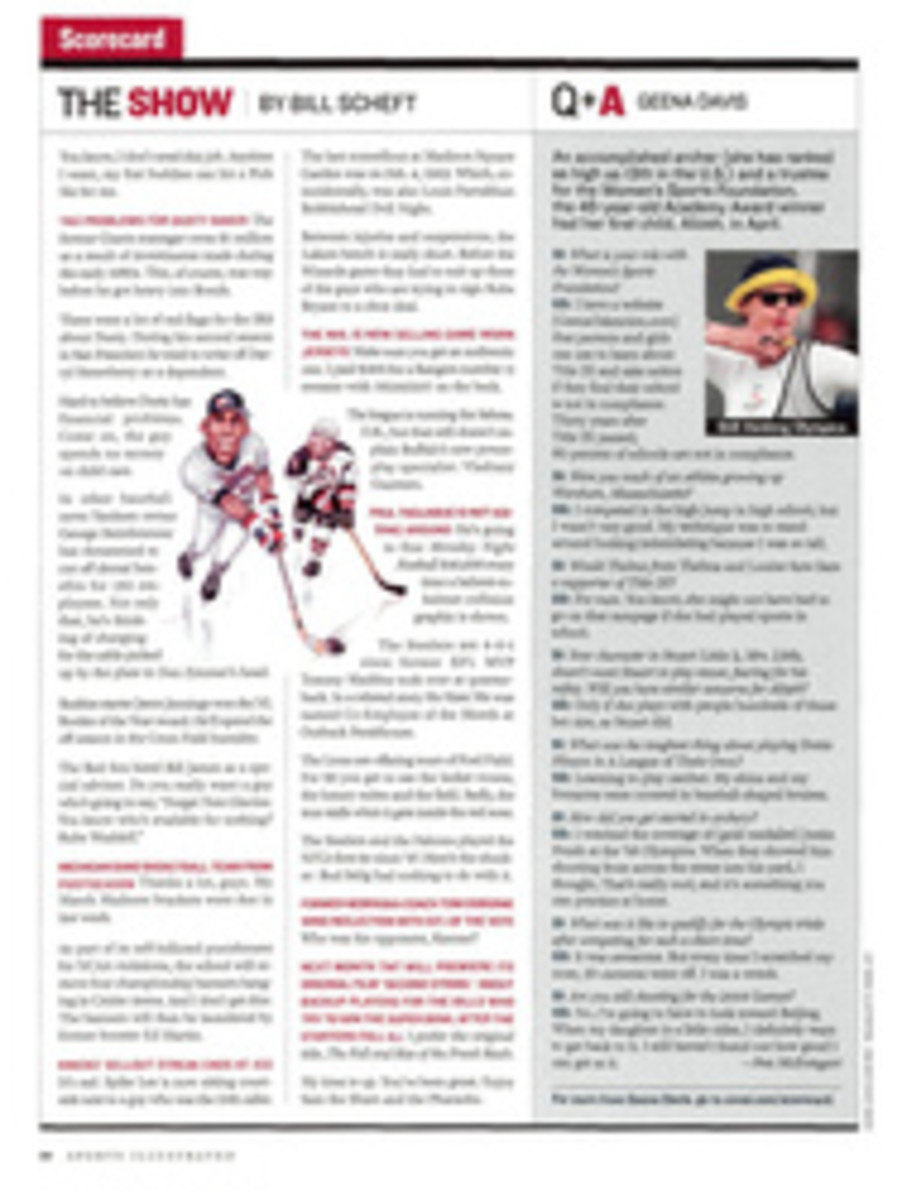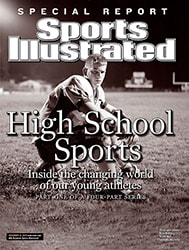
Why Everyone Hates The Leafs
Among the witches and hobgoblins and pint-sized Britney Spearses at the New York Islanders' kids Halloween costume contest before a game against the Phoenix Coyotes last month, Michael Conslato's outfit leaped out for its topicality. The seven-year-old paraded in a white Toronto Maple Leafs jersey with fake blood on the front and a bull's-eye on the back, a costume accentuated by his black eye and bloodied face. The crowd of more than 12,000 fans roared its approval for the homemade outfit that was meant to evoke Darcy Tucker, the Toronto pot-stirrer who had low-bridged Islanders star Michael Peca onto the operating table with a torn left ACL last spring during an intense and ugly first-round playoff series.
The Halloween getup struck a chord not only with Islanders fans still hungry for revenge but also with many players and executives inside the game who share ill will toward the Maple Leafs. To put it in trick-or-treat terms: In a poll, Toronto would be the team voted most worthy of an egging.
The Maple Leafs, who represent the undisputed capital of hockey--Greater Toronto supplies nearly 7% of NHL players--have evolved from a simple franchise into a monster over the past decade. The Maple Leafs last won the Stanley Cup in 1967 and spent the two decades after that victory as the Maple Laffs because of their ineptitude, but in many minds they have become the New York Yankees of hockey, save for the championships and the quiet dignity that has enveloped the Bronx in recent years. The Leafs are relatively successful but they are also jackhammer loud. They yap at referees, dive to get calls and bait officials at decibel levels that resonate throughout the league. "They have good players with a lot of skill," says Montreal Canadiens defenseman Sheldon Souray of the team that is the only Eastern Conference club to win a postseason series each of the last four years, "but the diving and the screaming cheapen the game."
"They expect to get all the calls, but when something is called against them, they whine," says Pittsburgh Penguins defenseman Ian Moran. "It's nonstop."
Tucker agrees that the moaning is "one of our downfalls as a team," but the example is set at the top. Pat Quinn, Toronto's coach and general manager, is only too willing to carp about officiating. While acknowledging his voluble approach, Quinn, an emotional man in an emotional sport, thinks resentment toward the Maple Leafs has more to do with their record the last several seasons than his broken record. "It goes along with success," he says. "If you think about teams which have succeeded and had a margin of physicality to them--whether they crossed the line or not is subjective--you'll see we hated the Big Bad Bruins [of the early 1970s], and we hated the Flyers when they were the Broad Street Bullies [in the mid-70s]. Both won Cups. We haven't won a Cup, but Toronto has been pretty successful, and there's a margin of physicality to some of our players. So when it comes to hating someone...."
Where to start? Maybe with right wing Tie Domi, the veteran enforcer. Domi committed one of the most vicious acts this side of Marty McSorley in the final minute of Game 4 of the 2001 playoffs when he coldcocked New Jersey Devils defenseman Scott Niedermayer with an elbow to the jaw a mile behind the play. The blow caused a concussion and earned Domi an eight-game suspension. That ban was not the first of his NHL career. During a match against the New York Rangers on Oct. 14, 1995, Domi sucker punched Ulf Samuelsson, a cheap shot that caused a concussion that was also worthy of an eight-game ban.
Then there is forward Shayne Corson, Tucker's brother-in-law and fellow Bruise Brother whose chippiness has increased in direct proportion to his decline as an offensive player. In Game 6 of that series against the Islanders last spring, he attempted to kick New York defenseman Eric Cairns during a fight, earning a one-game suspension. Toronto added to its mix of malfeasants last summer by signing free-agent goaltender Ed Belfour, formerly of the Dallas Stars. In March 2000 Belfour tried to out-Regis Regis when he allegedly offered Dallas cops $1 billion if they didn't throw him in jail after Belfour was arrested following a scuffle at a swank hotel.
Tucker, however, is the Leafs' lightning rod. He's skilled enough to occasionally play on the first line with the superb Mats Sundin (Tucker scored 24 goals last season) and theatrical enough that former teammates dubbed him Sideshow Bob. "I played with Darcy and like him off the ice," Montreal defenseman Craig Rivet says, "but I can't stand him on the ice, diving all over, embellishing whatever happens. Other guys suck it up and move on with the game. Not him."
Tucker, who played with even more of an edge earlier in his career with the Canadiens (1995--96 through '97--98) and the Tampa Bay Lightning ('97--98 through '99--2000), was not vilified until he arrived in Toronto. He cemented his notorious reputation by blowing out Peca's knee with that unpenalized hit. Somehow, Tucker also escaped suspension, but his low check did not go unnoticed. In a tape of unacceptable hits compiled by NHL vice president of hockey operations Mike Murphy and disseminated to every team during the preseason, the first clip was Tucker's low-bridge on Peca.
"That was crap," Buffalo Sabres enforcer Rob Ray says of the league's lack of discipline on Tucker, "not fining or suspending him and then sending out a tape saying this can't happen. Why didn't they do anything when it happened?"
In a universe based as much on perception as reality, resentment toward Toronto is ratcheted up because everyone thinks referees favor the Maple Leafs. "When I played for Toronto, I never thought about it," Philadelphia Flyers defenseman Chris McAllister, who was with the Leafs for parts of two seasons, says about officiating calls tilted toward Toronto. "But after I got traded and played against them, I felt they were getting calls in their favor most of the time. A lot of guys on other teams feel the same way."
The NHL's failure to suspend former Toronto goaltender Curtis Joseph for accidentally knocking down referee Mick McGeough in Game 3 of a first-round playoff series against the Ottawa Senators in 2000 reinforced the notion of bias. ("It was practically hilarious," Colin Campbell, NHL director of hockey operations, says of McGeough's pratfall, when an enraged Joseph, skating toward the ref, slipped and felled him like a tenpin.) The Flyers still simmer over a borderline elbowing penalty on John LeClair by referee Terry Gregson late in a scoreless tie that led to Toronto's series-winning power-play goal in the first round in 1999, a call that prompted an apoplectic Philadelphia chairman Ed Snider to demand to know where Gregson was born. The answer: Erin, Ont., about 40 miles from Toronto.
The NHL's hockey operations department is on the 11th floor of the Air Canada Tower, an elevator ride from Toronto's home ice. When the league first considered relocating the department from outside the city to downtown (it moved in 1999), commissioner Gary Bettman told Campbell that the NHL's executive committee was leery of putting the offices so close to the Air Canada Centre for fear the move might be perceived as favoring the Maple Leafs. Campbell somehow convinced the league that the move would be beneficial because it was closer to the action. "Are the Leafs a favored nation?" Campbell says. "I think the opposite is true. There's more exposure and coverage [in Toronto than anywhere else]. They can't get away with anything."
The Maple Leafs, of course, are a favored nation, by circumstance if not by formal decree. They are an anomaly in Canada, the land of the 64-cent dollar and mid-level payrolls. The fifth-highest average ticket price and strong corporate backing shield them from the sick Canadian buck, making the Leafs more like Rangers North than their fellow Canadian franchises. "With Maple Leaf Sports and Entertainment owning the [NBA] Raptors and the building," says Pittsburgh center Kent Manderville, who played in Toronto for four seasons, "it's almost like an American-style entertainment company."
The Maple Leafs are clearly favored by CBC's Hockey Night in Canada, which is even more profoundly consecrated as Saturday evening viewing in Canada than Friends and Seinfeld were on Thursday evenings for couch potatoes in the U.S. This season Hockey Night, probably the second most important institution in the sport besides the Stanley Cup, will air 27 games involving Toronto, 12 more than the Edmonton Oilers, the next most televised team. Maple Leafs telecasts have the No. 1 announcing team of Bob Cole and Harry Neale and the fervent good wishes of Don Cherry, who regularly trumpets his support for Toronto on his wildly popular Coach's Corner segment after the first period. Since 1989--90, the 10 top-rated Saturday night games and eight of the top 10 playoff matches have featured the Leafs even though they never reached a Cup final over that span.
"I remember watching the first three or four games of the Leafs-Kings semifinals on TV in New York in 1993," says James Patrick, a Sabres defenseman who played with the Rangers from '83--84 through '93--94. "It was a pretty good series. Dougie Gilmour was in his prime, going up against Wayne Gretzky. I had no preference. Then I went home to Winnipeg and caught the end of the series and was blown away by the biased coverage. Hockey Night wanted Toronto to win so badly, I instantly became the world's biggest Kings fan."
The crush of attention, and occasional fawning, have created a predictable backlash. "There is a certain swagger that comes with being a Leaf, which is probably why they're disliked," says former Toronto goalie Glenn Healy, who is a Hockey Night analyst. "Even the fourth-line guys on Toronto get car [endorsement] deals. In Atlanta fourth-line guys are lucky if they can afford to buy a car."
"If there is a little cock to our walk, it's not so much our doing," Tucker says. "Walk down the street, and people are hugging you like you're a movie star."
But in the corners and in the crease of NHL rinks outside Toronto, the most hated team in hockey is Sundin and a bunch of mother Tuckers.
COLOR PHOTO: PHOTOGRAPH BY LOU CAPOZZOLA SNEER CLEAR With his production down, Corson has ratcheted up his physical game, here giving Carolina's Sean Hill a face-lift.
COLOR PHOTO: J. MCISAAC/B. BENNETT STUDIOS KIDDER This costume mocking Tucker won the Isles' Halloween contest.
COLOR PHOTO: KEVIN FRAYER/AP (TOP) DOWN AND DIRTY Tucker's low-bridge sent Peca to surgery; Domi finds trouble even when he's already in the penalty box.
COLOR PHOTO: MILES KENNEDY/AP DOWN AND DIRTY Tucker's low-bridge sent Peca to surgery; Domi finds trouble even when he's already in the penalty box.
COLOR PHOTO: LOU CAPOZZOLA HERE'S THE RUB As Carolina's Erik Cole found out, Cory Cross and Toronto excel at dubious tactics such as face-washing.
"I like Darcy off the ice," says Rivet, "but I can't stand him on the ice, diving all over."
In a universe based as much on perception as reality, everyone thinks refs favor the Leafs.

